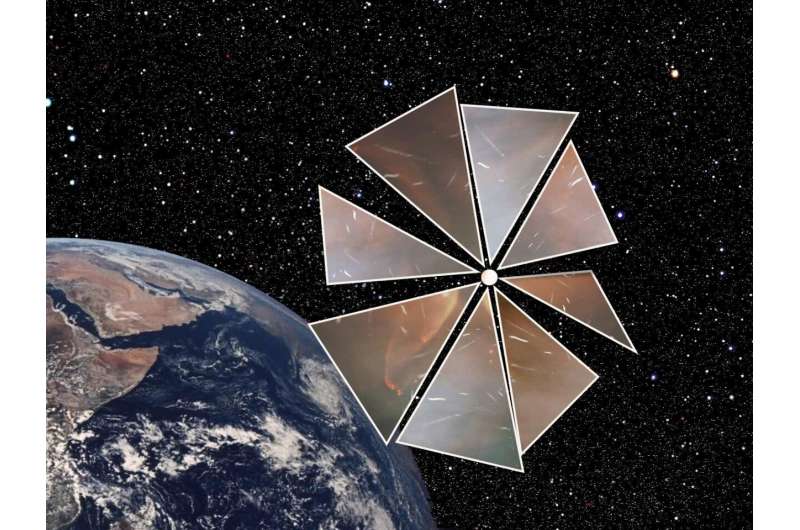A small satellite with a solar sail could catch up with an interstellar object

When ‘Oumuamua, the first interstellar object ever observed passing through the solar system, was discovered in 2017, it exhibited some unexpected properties that left astronomers scratching their heads. Its elongated shape, lack of a coma, and the fact that it changed its trajectory were all surprising, leading to several competing theories about its origin: was it a hydrogen iceberg exhibiting outgassing, or maybe an extraterrestrial solar sail (sorry folks, not likely) on a deep-space journey? We may never know the answer, because ‘Oumuamua was moving too fast, and was observed too late, to get a good look.
It may be too late for ‘Oumuamua, but we could be ready for the next strange interstellar visitor if we wanted to. A spacecraft could be designed and built to catch such an object at a moment’s notice. The idea of an interstellar interceptor like this has been floated by various experts, and funding to study such a concept has even been granted through NASA’s Innovative Advanced Concepts (NIAC) program. But how exactly would such an interceptor work?
A new paper released on ArXiv on June 27th explores one possible mission design. Derived from the NIAC study, the proposal suggests combining solar sail technology with the ability to miniaturize space probes to small, lightweight sizes.
Missions like JAXA’s IKAROS probe to Venus and the Planetary Society’s ongoing LightSail 2 project in Earth orbit have shown that solar sails, which use photons from the sun to accelerate, are entirely feasible propulsion systems. Similarly, the successful use of CubeSats on interplanetary missions was demonstrated by the Jet Propulsion Laboratory in 2018. They sent two CubeSats, named Mars Cube One (MarCO-a and MarCO-b), to accompany the InSight lander on its journey to the red planet. The CubeSats worked like a charm.
Artist’s impression of the first interstellar asteroid/comet, ‘Oumuamua. This unique object was discovered on 19 October 2017 by the Pan-STARRS 1 telescope in Hawaii. Credit: ESO/M. Kornmesser
When combined, solar sails and CubeSats could be a powerful tool for exploration.
To intercept an interstellar object, the paper proposes that a solar-sailing CubeSat could be launched ahead of time, ‘parking’ in an orbit around the sun where it would wait quietly for the discovery of the next interesting object worth chasing. A fast response vehicle like this would allows for various mission designs. A five-year mission, for example, could easily catch up and study an interstellar object, beaming back to Earth the kind of data that we failed to get from ‘Oumuamua. On the other hand, a similar spacecraft could even carry out a sample return mission, if given a longer timeframe of ten years.
One of the major engineering challenges for such a mission concerns the solar sail’s ability to manage heat. The interceptor would have to travel much closer to the sun than any previous solar sail tests, which usually use aluminum coated with Kapton. The properties of this material might enable it to survive within 0.15 AU of the sun without melting, but careful consideration will have to be given to shielding the control mechanisms and other spacecraft systems without adding too much to the spacecraft’s mass. Too heavy, and the sail won’t be able to catch up with the target.
The value of an interceptor spacecraft like this is pretty clear. Even though we’ve only seen two interstellar objects so far, they are probably passing by all the time. Better telescopes coming online this decade will help us find them, but they move fast, and don’t stay for long. If we want to study an interstellar object up close, we’re going to have to be ready for it, and a fast response interceptor spacecraft is likely our best chance at success.



 Creators of mankind
Creators of mankind Description of “Tall white aliens”
Description of “Tall white aliens” Where they came from?
Where they came from? About hostile civilizations
About hostile civilizations The war for the Earth
The war for the Earth “Tall white aliens” about eternal life
“Tall white aliens” about eternal life Video: “Nordic aliens”
Video: “Nordic aliens” Aliens
Aliens Alien encounters
Alien encounters The aliens base
The aliens base UFO
UFO Technology UFO
Technology UFO Underground civilization
Underground civilization Ancient alien artifacts
Ancient alien artifacts Military and UFO
Military and UFO Mysteries and hypotheses
Mysteries and hypotheses Scientific facts
Scientific facts


















